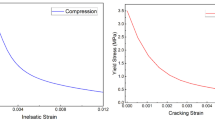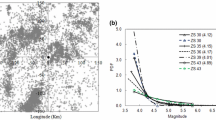Abstract
Purpose
This paper aims to define the non-linear response for concrete arch gravity dams, considering seismic actions as main external destabilizing actions.
Methods
The plastic degradation theory has been used to define the reduction of the elasto-plastic modulus during the hysteretic cycles. The parameters to apply the model are obtained from the literature and numerical analysis. In this sense, working with a reduction of the elasto-plastic modulus is useful to define the displacement of the structure. The seismic input has been obtained from probabilistic and deterministic seismic hazard analyses. For that, a series of several earthquakes have been chosen to perform the time–history analysis. The response of the structure blocks under four earthquakes has been made using a step-by-step direct integration. An application to Rules Dam has been made to test the method.
Results and conclusions
Results of the seismic analysis provide several specific accelerations for concrete arch gravity dams. Results of the structural show that in 2D analysis the maximum non-linear dam displacements reach value up to 27 cm, whereas for 3D analysis they reach up to 7 cm. Moreover, these cyclic displacements produce several accumulations of plastic deformations and cracks.





Similar content being viewed by others
References
Omidi O, Lofti V (2017) Seismic plastic-damage analysis of mass concrete blocks in arch dams including contraction and peripheral joints. Soil Dyn Earthq Eng 95:118–137
Zhang QL, Wang F, Gan XQ, Li B (2015) A field investigation into penetration cracks close to dam-to-pier interfaces and numerical analysis. Eng Fail Anal 57:188–201
Alembagheri M (2016) Earthquake damage estimation of concrete gravity dams using linear analysis and empirical failure criteria. Soil Dyn Earthq Eng 90:327–339
Omidi O, Lotfi V, Valliappan S (2012) Plastic-damage analysis of Koyna dam in different dam** mechanisms with dam–water interaction. In: 15th world conference on earthquake engineering, WCEE 2012, Lisbon, Portugal, pp 24–28
Guanglun W, Pekau OA, Chuhan Z, Shaomin W (2000) Seismic fracture analysis of concrete gravity dams based on nonlinear fracture mechanics. Eng Fract Mech 65:67–87
Wang JT, ** AY, Du XL, Wu M (2016) X, Scatter of dynamic response and damage of an arch dam subjected to artificial earthquake accelerograms. Soil Dyn Earthq Eng 87:93–100
Zacchei E, Molina JL, Brasil MLRF (2017) Seismic hazard assessment of arch dams via dynamic modelling: an application to the Rules Dam in Granada, SE Spain. Int J Civ Eng 17:323–332
Sabetta F, Pugliese A (1996) Estimation of response spectra and simulation of nonstationary earthquake ground motions. Bull Seismol Soc Am 86:337–352
Ambraseys NN, Simpson KA, Bommer JJ (1996) Prediction of horizontal response spectra in Europe. Earthq Eng Struct Dyn 25:371–400
Ambraseys NN, Douglas J, Sarma SK, Smit PM (2005) Equations for the estimation of strong ground motions from shallow crustal earthquakes using data from Europe and the Middle East: horizontal peak ground acceleration and spectral acceleration. Bull Earthq Eng 3:1–53
Gaspar-Escribano JM, Navarro M, Benito B, García-Jerez A, Vidal F (2010) From regional- to local-scale seismic hazard assessment: examples from Southern Spain. Bull Earthq Eng 8:1547–1567
Benito MB, Navarro M, Vidal F, Gaspar-Escribano J, García-Rodríguez MJ, Martínez-Solares JM (2010) A new seismic hazard assessment in the region of Andalusia (Southern Spain). Bull Earthq Eng 8:739–766
Fenves G, Chopra AK (1983) Effects of reservoir bottom absorption on earthquake response of concrete gravity dams. Earthq Eng Struct Dyn 11:809–829
Demirel E (2015) Numerical simulation of earthquake excited dam–reservoirs with irregular geometries using an immersed boundary method. Soil Dyn Earthq Eng 73:80–90
Mirzabozorg H, Varmazyari M, Ghaemian M (2010) Dam–reservoir-massed foundation system and travelling wave along reservoir bottom. Soil Dyn Earthq Eng 30:746–756
Chakrabarti P, Chopra AK (1973) Earthquake analysis of gravity dams including hydrodynamic interaction. Earthq Eng Struct Dyn 2:143–160
Seyedpoor SM, Salajegheh J, Salajegheh E (2010) Shape optimal design of arch dams including dam–water–foundation rock interaction using a grading strategy and approximation concepts. Appl Math Model 34:1149–1163
Lubliner J, Oliver J, Oller S, Oñate E (1989) A plastic-damage model for concrete. Int J Solids Struct 25:299–326
Oñate E, Oller S, Oliver J, Lubliner J (1988) A constitutive model for cracking of concrete based on the incremental theory of plasticity. Eng Comput 5:309–319
Chen HH, Su RKL (2013) Tension softening curves of plain concrete. Constr Build Mater 44:440–451
US Army Corps of Engineers (USACE) (1994) Arch dam design, Manual No. 1110-2-2201
Guan J, Li Q, Wu Z, Zhao S, Dong W, Zhou S (2015) Minimum specimen size for fracture parameters of site-casting dam concrete. Constr Build Mater 93:973–982
Li Q, Guan J, Wu Z, Dong W, Zhou S (2016) Equivalent maturity for ambient temperature effect on fracture parameters of site-casting dam concrete. Constr Build Mater 120:293–308
Hariri-Ardebili MA, Seyed-Kolbadi SM, Kianoush MR (2016) FEM-based parametric analysis of a typical gravity dam considering input excitation mechanism. Soil Dyn Earthq Eng 84:22–43
Hariri-Ardebili MA, Saouma V (2015) Quantitative failure metric for gravity dams. Earthq Eng Struct Dyn 44:461–480
Acknowledgements
The first author acknowledges the Servicios Informáticos CPD of the University of Salamanca for the Mathematica software license. The third author acknowledges support by CNPq, a Brazilian research funding agency.
Author information
Authors and Affiliations
Corresponding author
Additional information
Publisher's Note
Springer Nature remains neutral with regard to jurisdictional claims in published maps and institutional affiliations.
Rights and permissions
About this article
Cite this article
Zacchei, E., Molina, J.L. & Brasil, R.M.L.R.F. Nonlinear Degradation Analysis of Arch-Dam Blocks by Using Deterministic and Probabilistic Seismic Input. J. Vib. Eng. Technol. 7, 301–309 (2019). https://doi.org/10.1007/s42417-019-00112-5
Received:
Accepted:
Published:
Issue Date:
DOI: https://doi.org/10.1007/s42417-019-00112-5




